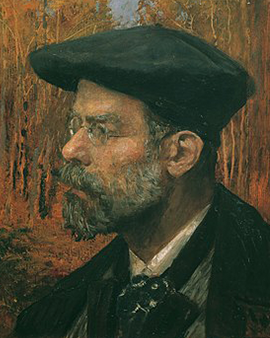


A remarkable chapter is emerging in the heart of the Austrian artistic landscape, involving the life story of Theodor Hörmann von Hörbach (b. December 13, 1840 in Imst, Tyrol; † July 1, 1895 in Graz), an excellent landscape painter. His life was marked by numerous twists and turns, beginning with his service in the Imperial Austrian Army, where he participated in the Sardinian War of 1859 and the German War of 1866, and ending with his remarkable rise to the rank of first lieutenant. His path to art began in 1873, when he interrupted his military career to study at the prestigious Vienna Academy of Fine Arts under Eduard Peithner von Lichtenfels von Lichtenfels and Anselm Feuerbach. As early as 1875 he was appointed teacher of freehand drawing and fencing at the military secondary school in Sankt Pölten. His military engagement finally ended with his marriage to Laura Bertuch in 1884. With newfound freedom, Hörmann began to expand his artistic abilities through extensive study trips.
The decisive change in Hörmann's artistic expressiveness occurred during his time in Paris (1886-1890). Here he discovered Impressionism, which had a profound influence on his further artistic development. After his return from Paris, he moved to Znojmo in 1890 and finally to Vienna in 1893, where he became a member of the Künstlerhaus in 1895. Hörmann's work is characterized by his vivid and colorful landscape paintings, always done in the open air, with a distinctive style known as Austrian Mood Impressionism. His works were often enlivened by figural staffages, which gave them an added dimension.
Despite his contemporaries' initial skepticism of his vivid color choices, his style gained recognition shortly before his death under the influence of Emil Jakob Schindler. However, it was not until after his death that Hörmann's art was fully appreciated, when Hermann Bahr called him the first Secessionist. The artistic magnitude and importance of Hörmann's work is honored through our collection of high quality art prints of his works. As a viewer of these art prints, you can encounter the vibrant colors and atmospheric landscapes that Hörmann so masterfully captured. Each art print offers the opportunity to embark on a visual journey, allowing us to see the world through the eyes of this remarkable Austrian landscape painter.

A remarkable chapter is emerging in the heart of the Austrian artistic landscape, involving the life story of Theodor Hörmann von Hörbach (b. December 13, 1840 in Imst, Tyrol; † July 1, 1895 in Graz), an excellent landscape painter. His life was marked by numerous twists and turns, beginning with his service in the Imperial Austrian Army, where he participated in the Sardinian War of 1859 and the German War of 1866, and ending with his remarkable rise to the rank of first lieutenant. His path to art began in 1873, when he interrupted his military career to study at the prestigious Vienna Academy of Fine Arts under Eduard Peithner von Lichtenfels von Lichtenfels and Anselm Feuerbach. As early as 1875 he was appointed teacher of freehand drawing and fencing at the military secondary school in Sankt Pölten. His military engagement finally ended with his marriage to Laura Bertuch in 1884. With newfound freedom, Hörmann began to expand his artistic abilities through extensive study trips.
The decisive change in Hörmann's artistic expressiveness occurred during his time in Paris (1886-1890). Here he discovered Impressionism, which had a profound influence on his further artistic development. After his return from Paris, he moved to Znojmo in 1890 and finally to Vienna in 1893, where he became a member of the Künstlerhaus in 1895. Hörmann's work is characterized by his vivid and colorful landscape paintings, always done in the open air, with a distinctive style known as Austrian Mood Impressionism. His works were often enlivened by figural staffages, which gave them an added dimension.
Despite his contemporaries' initial skepticism of his vivid color choices, his style gained recognition shortly before his death under the influence of Emil Jakob Schindler. However, it was not until after his death that Hörmann's art was fully appreciated, when Hermann Bahr called him the first Secessionist. The artistic magnitude and importance of Hörmann's work is honored through our collection of high quality art prints of his works. As a viewer of these art prints, you can encounter the vibrant colors and atmospheric landscapes that Hörmann so masterfully captured. Each art print offers the opportunity to embark on a visual journey, allowing us to see the world through the eyes of this remarkable Austrian landscape painter.
Page 1 / 1






